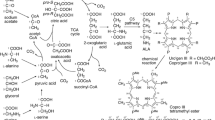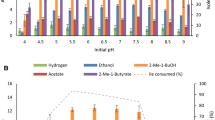Abstract
Cultures of the autotrophic bacteriumMethanobacterium thermoautotrophicum were shown to assimilate acetate when grown on CO2 and H2 in the presence of acetate. At 1 mM acetate 10% of the cell carbon came from acetate, the rest from CO2. At higher concentrations the percentage increased to reach a maximum of 65%at acetate concentrations higher than 20 mM. The data suggest that acetate may be an important carbon source under physiological conditions.
The incorporation of acetate into alanine, aspartate and glutamate was studied in more detail. The cells were grown on CO2 and H2 in the presence of 1 mM U-14C-acetate. The three amino acids were isolated from the labelled cells by a simplified procedure. Alanine, aspartate and glutamate were found to have the same specific radioactivity. Degradation studies showed that C1 of alanine C1 and C4 of aspartate, and C1 and C5 of glutamate were exclusively derived from CO2, whereas C2 and C3 alamine and aspartate, and C3 and C4 of glutamate were partially derived from acetate. These findings and the presence of pyruvate synthase, phosphoenolpyruvate carboxylase and α-ketoglutarate synthase inM. thermoautotrophicum indicate that CO2 is assimilated into the three amino acids via acetyl CoA carboxylation to pyruvate, phosphoenolpyruvate carboxylation to oxaloacetate, and succinyl CoA carboxylation to α-ketoglutarate.
Similar content being viewed by others
References
Andrew, I. G., Morris, J. G.: The biosynthesis of alanine byClostridium kluyveri. Biochim. Biophys. Acta97, 176–179 (1965)
Aronoff, S.: Techniques of radiobiochemistry, p. 141. Iowa: Iowa State College Press 1956
Bray, G. A.: A simple efficient liquid scintillator for counting aqueous solutions in a liquid scintillation counter. Anal. Biochem.1, 279–285 (1960)
Bryant, M. P., Tzeng, S. F., Robinson, I. M., Joyner, A. E.: Nutrient requirements of methanogenic bacteria. In: Anaerobic treatment processes. Advances in chemistry, Vol. 105 (F. G. Pohland, ed.), pp. 23–40. Washington, D. C.: Amer. Chem. Soc. 1971
Buchanan, B. B.: Ferredoxin and carbon assimilation. In: Iron sulfur proteins, Vol. 1 (W. Lovenberg, ed.), pp. 129–150. New York-London: Academic Press 1973
Cutinelli, C., Ehrensvärd, G., Högström, G., Reio, L., Saluste, E., Sternholm, R.: Acetic acid metabolism inRhodospirillum rubrum under anaerobic conditions. Ark. Kemi3, 501–509 (1951)
Daniels, L., Zeikus, J. G.: Abstr. Annu. Meet. Am. Soc. Microbiol.158, p. 121 (1976)
Gottschalk, G.: The stereospecificity of the citrate synthase in sulfate-reducing and photosynthetic bacteria. Eur. J. Biochem.5, 346–351 (1968)
Gottschalk, G., Barker, H. A.: Synthesis of glutamate and citrate byClostridium kluyveri. A new type of citrate synthase. Biochemistry5, 1125–1133 (1966)
Grassl, M.: Alanin-Bestimmung mit GPT und LDH. In: Methoden der enzymatischen Analyse. Vol. 2 (H. U. Bergmeyer, ed.), pp. 1637–1640. Weinheim: Verlag Chemie 1970
Hoare, D. S.: The photoassimilation of acetate byRhodospirillum rubrum. Biochem. J.87, 284–301 (1963)
Hoare, D. S., Gibson, J.: Photoassimilation of acetate and the biosynthesis of amino acids byChlorobium thiosulfatophilum. Biochem. J.91, 546–559 (1964)
Hohorst, H.-J.:l-(+)-Lactat-Bestimmung mit Lactat-Dehydrogenase und NAD. In: Methoden der enzymatischen Analyse, Vol. 2 (H. U. Bergmeyer, ed.), pp. 1425–1429. Weinheim: Verlag Chemie 1970
Hungate, R. E.: A roll tube method for cultivation of strict anaerobs. In: Methods in Microbiology, Vol. 3B (J. R. Norris, D. W. Ribbons, eds.), pp. 117–132. New York-London: Academic Press 1969
Jungermann, K., Thauer, R. K., Wenning, J., Decker, K.: Confirmation of unusual stereochemistry of glutamate biosynthesis inClostridium kluyveri. FEBS Letters1, 74–76 (1968)
Kedenburg, C. P.: Lithium buffer system for accelerated singlecolumn amino acid analysis in physiological fluids. Anal. Biochem.40, 35–42 (1971)
Kelly, D. P.: The incorporation of acetate by the chemoautotrophThiobacillus neapolitanus strain C. Arch. Mikrobiol.58, 99–116 (1967)
Kemble, A. R., Macpherson, H. T.: Determination of monoamino monocarboxylic acids by quantitative paper chromatography. Biochem. J.56, 548–555 (1954)
Ljungdahl, L. G., Wood, H. G.: Total synthesis of acetate from CO2 by heterotrophic bacteria. Ann. Rev. Microbiol.23, 515–538 (1969)
Roberts, R. B., Abelson, P. H., Cowie, D. B., Bolton, E. T., Britton, R. J.: Studies of biosynthesis inEscherichia coli. Carnegie Institute. Washington (1957)
Stegemann, H.: Bestimmung von Aminosäuren mit dithionitreduziertem Ninhydrin. Hoppe-Seyler's Z. Physiol. Chem.319, 102–109 (1960)
Simon, H., Floss, H. G.: Anwendung von Isotopen in der organischen Chemie und Biochemie, Vol. 2, pp. 23ff., 50ff. Berlin-Heidelberg-New York: Springer 1967
Taylor, G. T., Kelley, D. P., Pirt, S. J.: Intermediary metabolism in methanogenic bacteria. In: Proceedings of the Symposium “Microbial production and utilization of gases (H2, CH4, CO)” (H. G. Schlegel, G. Gottschalk, N. Pfennig, eds.), pp. 173–180, Akademie der Wissenschaften zu Göttingen. Göttingen: Goltze 1976
Thauer, R. K., Jungermann, K., Wenning, J., Decker, K.: Characterization of crotonate grownClostridium kluyveri by its assimilatory metabolism. Arch. Mikrobiol.64, 125–129 (1968)
Tomlinson, N.: Carbon dioxide and acetate utilization byClostridium kluyveri. II. Synthesis of amino acids. J. Biol. Chem.209, 597–603 (1954a)
Tomlinson, N.: Carbondioxide and acetate utilization byClostridium kluyveri. III. A new path of glutamic acid synthesis. J. Biol. Chem.209, 605–609 (1954b)
Tomlinson, N., Barker, H. A.: Carbon dioxide and acetate utilization byClostridium kluyveri. I. Influence of nutritional conditions on utilization patterns. J. Biol. Chem.209, 585–595 (1954)
Zeikus, J. G.: The biology of methanogenic bacteria. Bact. Rev.41, 514–541 (1977)
Zeikus, J. G., Fuchs, G., Kenealy, W., Thauer, R. K.: Oxidoreductases involved in cell carbon synthesis ofMethanobacterium thermoautotrophicum. J. Bacteriol.132, 604–613 (1977)
Zeikus, J. G., Weimer, P. J., Nelson, D. R., Daniels, L.: Bacterial methanogenesis: Acetate as a methane precursor in pure culture. Arch. Microbiol.104, 129–134 (1975)
Zeikus, J. G., Wolfe, R. S.:Methanobacterium thermoautotrophicum sp. n., an anaerobic, autotrophic, extreme thermophile. J. Bacteriol.109, 707–713 (1972)
Author information
Authors and Affiliations
Rights and permissions
About this article
Cite this article
Fuchs, G., Stupperich, E. & Thauer, R.K. Acetate assimilation and the synthesis of alanine, aspartate and glutamate inMethanobacterium thermoautotrophicum . Arch. Microbiol. 117, 61–66 (1978). https://doi.org/10.1007/BF00689352
Received:
Issue Date:
DOI: https://doi.org/10.1007/BF00689352




